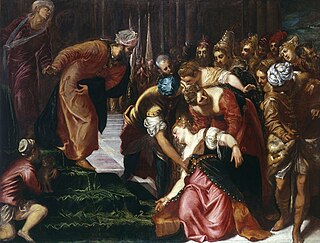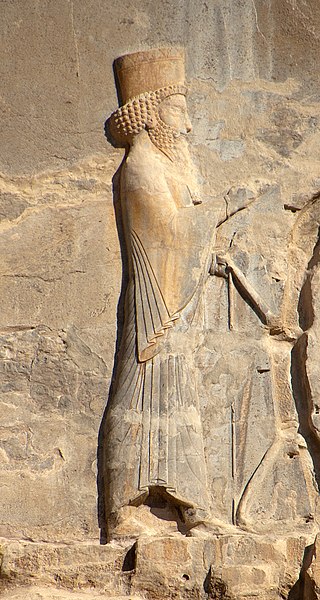
Xerxes I, commonly known as Xerxes the Great, was a Persian ruler who served as the fourth King of Kings of the Achaemenid Empire, reigning from 486 BC until his assassination in 465 BC. He was the son of Darius the Great and Atossa, a daughter of Cyrus the Great. In Western history, Xerxes is best known for his invasion of Greece in 480 BC, which ended in Persian defeat. Xerxes was designated successor by Darius over his elder brother Artobazan and inherited a large, multi-ethnic empire upon his father's death. He consolidated his power by crushing revolts in Egypt and Babylon, and renewed his father's campaign to subjugate Greece and punish Athens and its allies for their interference in the Ionian Revolt. In 480 BC, Xerxes personally led a large army and crossed the Hellespont into Europe. He achieved victories at Thermopylae and Artemisium before capturing and razing Athens. His forces gained control of mainland Greece north of the Isthmus of Corinth until their defeat at the Battle of Salamis. Fearing that the Greeks might trap him in Europe, Xerxes retreated with the greater part of his army back to Asia, leaving behind Mardonius to continue his campaign. Mardonius was defeated at Plataea the following year, effectively ending the Persian invasion.

Ahasuerus is a name applied in the Hebrew Bible to three rulers of Ancient Persia and to a Babylonian official first appearing in the Tanach in the Book of Esther and later in the Christian Book of Tobit. It is a transliteration of either Xerxes I or Artaxerxes; both are names of multiple Achaemenid dynasty Persian kings.

Arses, known by his regnal name Artaxerxes II, was King of Kings of the Achaemenid Empire from 405/4 BC to 358 BC. He was the son and successor of Darius II and his mother was Parysatis.

The Battle of Mycale was one of the two major battles that ended the second Persian invasion of Greece during the Greco-Persian Wars. It took place on or about August 27, 479 BC on the slopes of Mount Mycale, on the coast of Ionia, opposite the island of Samos. The battle was fought between an alliance of the Greek city-states, including Sparta, Athens and Corinth, and the Persian Empire of Xerxes I.

The Greco-Persian Wars were a series of conflicts between the Achaemenid Empire and Greek city-states that started in 499 BC and lasted until 449 BC. The collision between the fractious political world of the Greeks and the enormous empire of the Persians began when Cyrus the Great conquered the Greek-inhabited region of Ionia in 547 BC. Struggling to control the independent-minded cities of Ionia, the Persians appointed tyrants to rule each of them. This would prove to be the source of much trouble for the Greeks and Persians alike.

Atossa was an Achaemenid empress. She was the daughter of Cyrus the Great, and the wife of Darius the Great.
Mardonius was a leading Persian military commander during the Persian Wars with Greece in the early 5th century BC who died at the Battle of Plataea.

Pausanias was a Spartan regent and a general. In 479 BC, as a leader of the Hellenic League's combined land forces, he won a pivotal victory against the Achaemenid Empire in the Battle of Plataea. Despite his role in ending the Second Persian invasion of Greece, Pausanias subsequently fell under suspicion of conspiring with the Persian king Xerxes I. After an interval of repeated arrests and debates about his guilt, he was starved to death by his fellow Spartans in 477 BC. What is known of his life is largely according to Thucydides' History of the Peloponnesian War, Diodorus' Bibliotheca historica and a handful of other classical sources.
Amestris was a Persian queen, the wife of Xerxes I of Persia, mother of Achaemenid King of Kings Artaxerxes I of Persia.
Parysatis was a Persian queen, consort of Darius II and had a large influence during the reign of Artaxerxes II.

Tiribazus, Tiribazos or Teribazus was an Achaemenid satrap of Armenia and later satrap of Lydia in western Anatolia.

The Achaemenid dynasty was a royal house that ruled the Persian Empire, which eventually stretched from Egypt and the Balkans in the west to Central Asia and the Indus Valley in the east.

Nebuchadnezzar IV, alternatively spelled Nebuchadrezzar IV and also known by his original name Arakha, was a nobleman of Urartian (Armenian) descent who in 521 BC seized power in Babylon, becoming the city's king and leading a revolt against the Persian Achaemenid Empire. His revolt began less than a year after the unsuccessful revolt of Nebuchadnezzar III and like his predecessor, Arakha assumed the name Nebuchadnezzar and claimed to be a son of Nabonidus, Babylon's last independent king.
Artystone also known as Irtašduna in the Fortification tablets, was a Persian princess, daughter of king Cyrus the Great, and sister of Cambyses II, Atossa and Smerdis (Bardiyā). Along with Atossa and her niece Parmys, Artystone married king Darius I. It is argued that by marrying the female offspring of Cyrus, the founder of the empire, the new king aimed to prevent his rule from being contested, since Darius himself was not of royal blood.
Amytis was an Achaemenid princess, daughter of king Xerxes I and queen Amestris, and sister of king Artaxerxes I.
Artaynte, was the wife of the Crown Prince Darius.

Nebuchadnezzar III, alternatively spelled Nebuchadrezzar III and also known by his original name Nidintu-Bêl, was a rebel king of Babylon in late 522 BC who attempted to restore Babylonia as an independent kingdom and end the rule of the Persian Achaemenid Empire in Mesopotamia. A Babylonian noble of the Zazakku family and the son of a man by the name of Mukīn-zēri or Kîn-Zêr, Nidintu-Bêl took the regnal name Nebuchadnezzar upon his accession to the Babylonian throne and claimed to be a son of Nabonidus, Babylon's last independent king.

The Achaemenid Empire or Achaemenian Empire, also known as the First Persian Empire, was the ancient Iranian empire founded by Cyrus the Great of the Achaemenid dynasty in 550 BC. Based in modern-day Iran, it was the largest empire by that point in history, spanning a total of 5.5 million square kilometres. The empire spanned from the Balkans and Egypt in the west, West Asia as the base, the majority of Central Asia to the northeast, and the Indus Valley to the southeast.

Boges was a Persian official and military commander, who functioned as governor (hyparchos) of Eion in Thrace under the King of Kings Xerxes I. According to Herodotus, following the Persian defeats at Plataea and Mycale, Boges refused to abandon Eion when it was besieged by the Athenians and Cimon in 476/5. When he perhaps could have surrendered the town and marched out safely, Boges decided to endure till the end, as he wished not to suffer the ignominy of falling into the enemy’s hands. When the provisions of Eion had finally run out during the protracted siege, Boges built a large fire, killed his wife, children, concubines and servants, and threw them into the fire. He then reportedly collected all pieces of silver and gold that were stored in Eion and threw them into the river Strymon. He then threw himself onto the fire. Boges was highly honored by Xerxes I for his valiance and loyalty, and even Herodotus himself concurred. When Herodotus wrote his Histories in the second half of the fifth century BC, Boges was still praised by the Persians for his deeds. The children of Boges who survived within the Achaemenid Empire were also greatly honoured by Xerxes I.
Persica is a lost Ancient Greek text, divided in 23 books, on Assyrian, Median and Persian history written by Ctesias of Cnidus, a physician at the court of the Persian king Artaxerxes II. The work's style and value for the study of the Achaemenid history have been a subject of much controversy among modern scholars.















